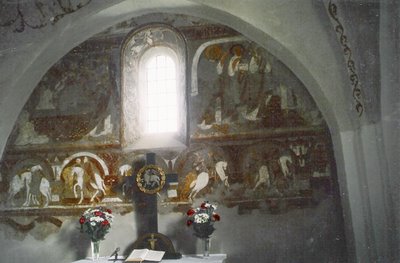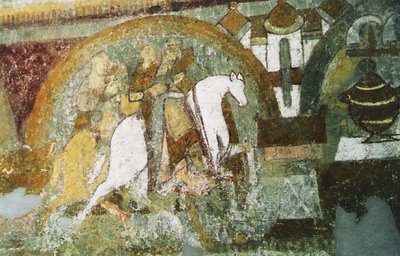Skibet Church, Vejle

Skibet church, 'Rytterfrisen' (The Horsemen's Frieze') 1100s
(Above the Horsemen's frieze are two scenes from the New Testament, to the left Lazarus and to the right Christ and the disciples.)
During the ruling period of Valdemar Sejr and Valdemar the Great - between 1157 and 1241 - about 2000 stone churches were built inside the present borders of Denmark. (1700 old churches still exist.) The building activity was immense all over the country ; much influence and inspiration came from abroad, and some of it came from England. English master builders, stone masons and artists arrived - and they were responsible for some fine Anglo-Normannic inspired churches, especially in the north western part of Jutland.
One English artist might have travelled a little further down south - and he arrived to the location Skibet in the eastern part of Jutland, where a little stone church was built in the middle of the 1100s. Here he was possibly the creator of some magnificent frescoes called 'Rytterfrisen' (The Horsemen's Frieze') , which is unprecedented in Denmark.

Skibet church. Two saddled horses and some horsemen riding slowly and with dignity to the north.

Skibet church. Some gallopping horsemen moving towards the jar, considered to be the key to the story. Behind is a city or a temple.
Hornslet Church, Aarhus

Hornslet church: A fully armed knight rides toward west, the crowned bedridden man recieves the Holy Communion from a cleric.
In Hornslet church north of Århus are frescoes from the first half of the 1200s, telling a similar story like in Skibet. It's a unique phenomenon that Jutland unlike the eastern part of Denmark is able to show those spectacular and dramatic scenes with horsemen.
The interpretation is open in both cases. Some have suggested that the story is from the colourful tale about the prophets - but both before and now it is believed that the frescoes are about the legend of the Holy Grail, which was known in Denmark already in the Viking period.

Hornslet church: A little angel in a medaillon above the window might represent the Grail with the blood of Christ, and the crowned man in the previous shown picture is the deadly sick king who can only survive in the virtue of the Holy Communion, and the knight to the left of the king is Percival riding out in search of the Grail. The war scene belov is one of the famous battle scenes from the legend's compulsory material.

Hornslet church. A dramatic battle scene in front of a town wall or a castle. In one of the castle towers an archer is shooting an arrow with great power.

Hornslet church. A part of the battle scene.
What the fine English artist supposedly painted in a little newbuilt church in Jutland in the middle of the 1100s is now one of very few medieval representations of the Holy Grail on Danish ground.
photo Skibet church + Hornslet church 2003/2007: grethe bachmann
Source:
Trap Danmark: Vejle amt
Gyldendal og Politikens Danmarkshistorie, bind 4
Gyldendals bog om Danmarks kirker.
Gyldendals bog om Danske kalkmalerier.
2 comments:
Remarkable finds to enjoy. I like the bridge being found also. Often we lose history from the story not being retold.
Hello Steve, yes, I love too when they find something like this and can tell us something about it.
I love the story about the Holy Grail. The Arthur-Saga.
Cheers and have a nice week-end
Grethe ´)
Post a Comment